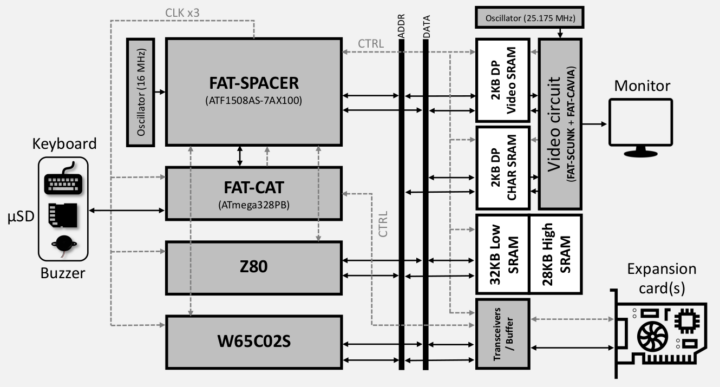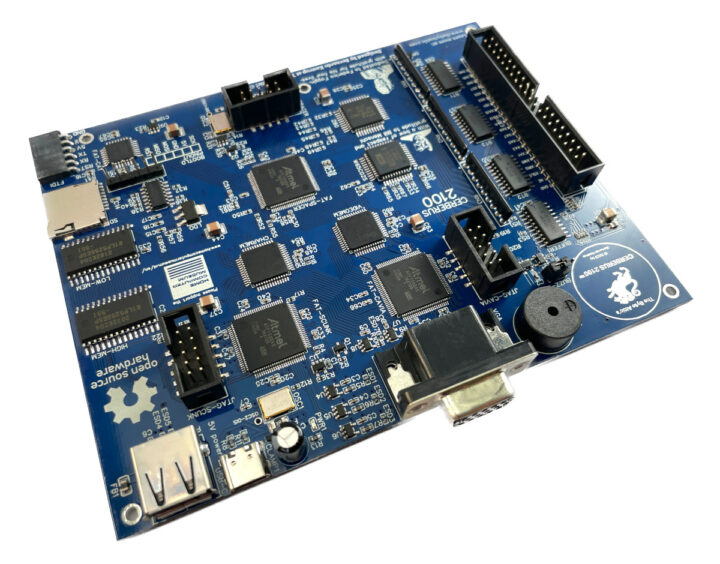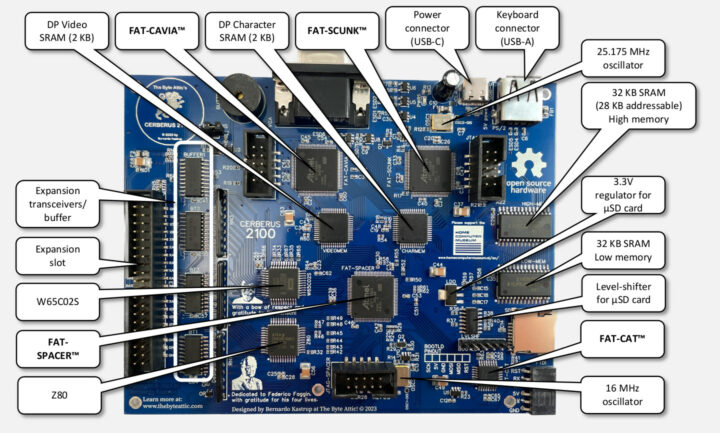Olimex has just announced the launch of the CERBERUS 2100 open-source hardware, educational, multi-processor 8-bit computer with both Z80 and 6502 CPUs, as well as a Microchip AVR processor serving as an I/O controller.
The CERBERUS 2100 features several CPLD and is fully programmable from the lowest level (individual gates and flip-flops) up to BASIC interpreters running on the Z80 and 6502 CPUs. Olimex did not design this themselves as the hardware design is from Bernardo Kastrup (aka TheByteAttic), while BASIC interpreters were written by Alexander Sharikhin (6502) and Dean Belfield (Z80).
CERBERUS 2100 specifications:
- Processors
- CPLDs (ATF1508AS-7AX100)
- FAT-SCUNK (Scan CoUNter and clocK) and FAT-CAVIA (ChAracter Video Adapter) for video circuit connected to a 25.175 MHz oscillator
- FAT-SPACER (Serial to PArallel ControllER) for signals, clocks, serial<->parallel conversion connected to a 16 MHz oscillator
- Memory – 64 KB of user-addressable RAM
- Storage – MicroSD card slot with filesystem built into the BIOS (AVR)
- Video output and graphics support
- VGA video output with 320×240 resolution (note: actually 640×480 with 2×2 pixels)
- Character-based with 40×30 individually addressable characters
- Up to 8 simultaneous screen colors
- On-the-fly user-redefinable character bitmaps for tile graphics
- Debugging – 3x JTAG connectors
- Expansion – 40-pin expansion slot with generic I/O protocol going through FAT-CAT and FAT-SPACER CPLDs
- Misc
- Standard PS/2-compatible USB keyboard
- Buzzer
- Power Supply – 5V via USB-C port

The BIOS code is written in C and compiled under the Arduino IDE, and excluding video signals, the FAT-CAT performs all I/O functions such as file system operations, keyboard & expansion control, and
sound output, and supports DMA transfers the FAT-SPACER.
You’ll find the hardware design files, firmware, and detailed documentation on GitHub and TheByteAttic website. People who prefer video content may also watch the 45-minute video introduction below.
Bernardo Kastrup provides all files for manufacturing but does not do that himself, instead, Bulgarian company Olimex handles that and is currently selling the CERBERUS 2100 board for 219 Euros

Jean-Luc started CNX Software in 2010 as a part-time endeavor, before quitting his job as a software engineering manager, and starting to write daily news, and reviews full time later in 2011.
Support CNX Software! Donate via cryptocurrencies, become a Patron on Patreon, or purchase goods on Amazon or Aliexpress






